 |
|
 |
| |
Ivy House
Paper Mill
By 1800 there were 430 papermills in England and Wales (mostly single vat mills),
but all the production was by hand and the output was low. The first attempt at a paper machine to mechanise the process was patented in 1799 by Frenchman Nicholas Louis Robert, but it was not a success. However, the drawings were brought to England by John Gamble in 1801 and passed on to the brothers Henry and Sealy Fourdrinier, who financed the engineer Bryan Donkin to build the machine.
Despite stiff opposition from other paper manufacturers
the Fourdrinier brothers built up a business at the Ivy House Estate on the
outkirts of Hanley producing tissue paper for pottery engraving as well as ordinary paper.
It was taken over by Thomas Brittain in 1855, and in 1890 his grandson, Thomas Arthur Brittain, and two other members of the family bought a
further paper mill at Cheddleton and incorporated the two businesses as Brittains Ltd.
Paper-making eventually ceased at the Ivy House Mill which was rebuilt and since 1906 has been devoted to paper coating and finishing.
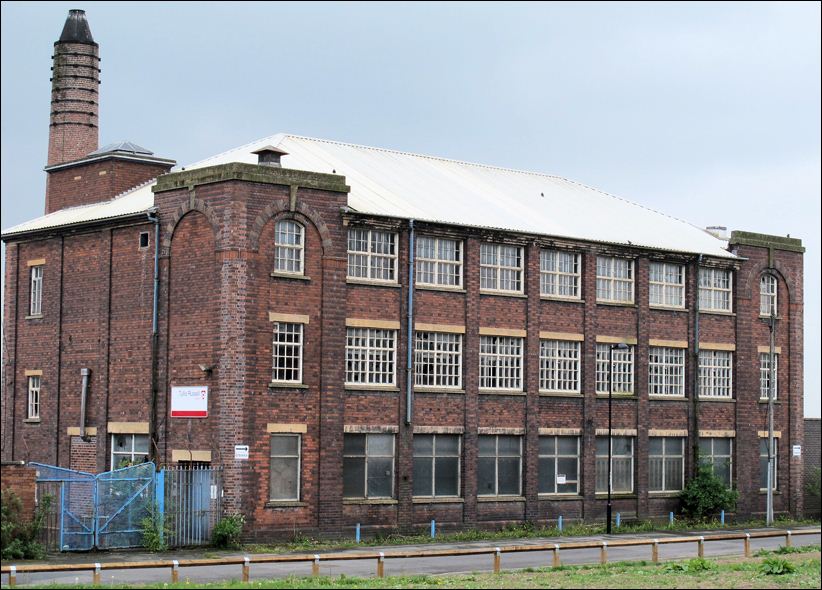
The Brittains Sort & Pack
Warehouse on Commercial Road
built in 1924
photo: May 2010
Timeline of the site
-
The
site was first developed as a corn mill in the 1780's.
-
It
was converted to a pumping house in the 1820's
-
The Ivy House paper mill was founded
on the site by G. H. Fourdrinier in 1827, specialising
in the production of paper for use in the neighbouring potteries.
[Pigot's trade directory of 1828-1829 suggests that Fourdrinier were
at this time also operating from premises in Brownhills.
-
George
Henry Fourdrinier & Co. continued operating from Ivy House Mills
until they were declared bankrupt in 1854.
-
In
1855 Ivy House Mill was purchased by Thomas Brittain & Son,
describing themselves as ‘successors to the Fourdriniers, the
inventors of the paper machine’.
-
In
a 1870 trade directory the mill is listed as occupied by ‘Brittain,
T. & Son, pottery tissue manufacturer’.
-
In
1890 production at Ivy House Mill was amalgamated with that at the
nearby Cheddleton Mill and a new company was formed and incorporated
under the title of ‘Brittains Limited’.
-
In
1906 all mechanised paper-making processes at Ivy House Mills were
moved to the much larger Cheddleton Mill - at the Ivy House
Mill a new mill building added and the works developed as a paper
coating works and warehouse.
-
Brittains
continued to operate the Ivy House Mills site throughout the first
half of the 20th century.
-
In
1952 Ivy House Mill is reported as occupying a 2.5 acre site with a
frontage running 235 feet along Commercial Road. At some prior time
Brittains had acquired the site of the former Dresden Mills in order
to extend their buildings. In 1952 Ivy House Mills was reported as
having buildings containing paper coating and conversion machinery.
The inventory details offices, a chapel, coating mills and
warehousing, alongside fitter’s shops and calendaring rooms (for
the polishing of paper).
-
The
site was taken over by Tullis Russell & Co. in the 1970s, and
they continued to produce Decalcomania Papers under the name Tullis
Russell Brittains.
-
The
site closed in 2006 and was purchased by Seddon Homes and most of
the site demolished with the exception of the warehouse on
Commercial Road, a chimney and one building adjacent to the 1907
mill - which formed part of a conservation area.
-
In
December 2012 Seddon made a planning application to demolish the
remainder of the buildings and build 62 houses.
|
| Fourdriniers,
the inventors of the paper machine
|
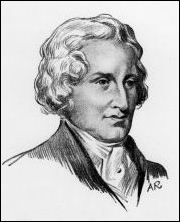
Henry Fourdrinier
(1766–1854
|
In Henry
Fourdrinier was trading as a stationary business
with his brother Sealy Fourdrinier and William Bloxham when they met John Gamble who was seeking an English patent on a machine for making paper in continuous rolls, devised by Nicolas Robert and patented in France in 1799. They bought a one-third share in his patent rights.
The first machine was imported and erected at J. and E. Hall, the Fourdriniers' millwright. There, a third brother, Charles Fourdrinier, worked alongside John Gamble, Leger Didot, and Bryan Donkin (one of Hall's former apprentices), to develop it.
Later they installed it in a mill at Frogmore, Hertfordshire, acquired for the purpose. |
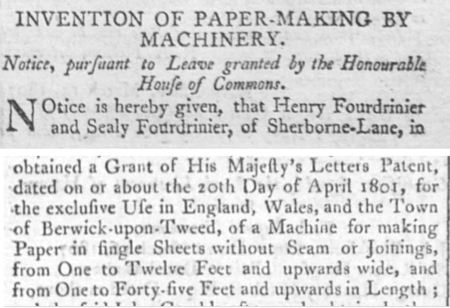
Fourdrinier request for
a patent 'on or about the 20th day of April 1801'
"... of a machine for making paper in single sheets without
seam or joinings,
from one to twelve feet and upwards wide, and from one to forty-five
feet
and upwards in length.."
-
Louis
Nicholas Robert patented the first papermaking machine in
1798.
-
The
Fourdrinier brothers, stationers operating in London, bought the
patent, and with engineer Bryan Donkin set about improving the
design.
-
The
first Fourdrinier paper machine was built in 1804, it revolutionised
the paper making industry enabling the manufacture of a continuous
sheet of paper.

November
1836
notice of an application to prolong the term of the patent
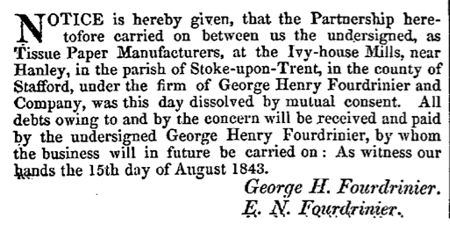
August
1843
George Henry and Edward Newman Fourdrinier
were sons of Henry Fourdrinier
Notices:
The London Gazette

1834
William White - Directory of Staffordshire
-
The
Ivy House site may have been acquired for the production of paper by
George Fourdrinier in 1827 but the trade directory of 1828-1829
suggests that Fourdrinier were at this time operating from premises
in Brownhills.
-
George
Henry Fourdrinier & Co. are recorded as operating from Ivy House
Mills in 1834 and continued operating from Ivy House Mills until
they were declared bankrupt in 1854.
|
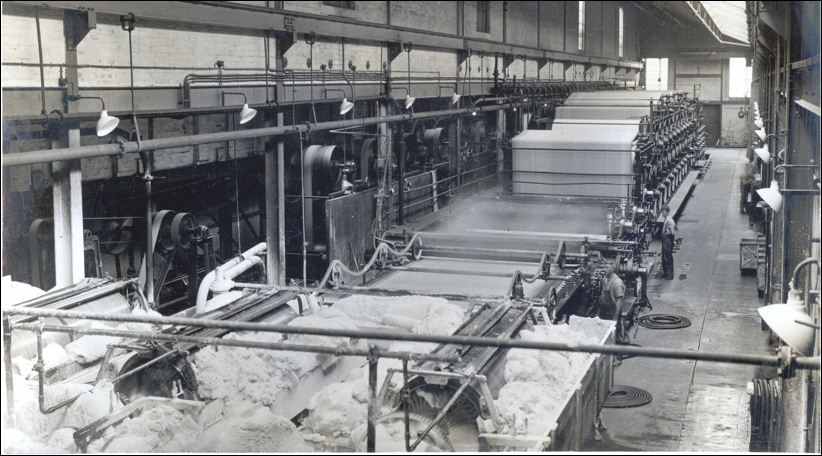
|
Fourdrinier
papermaking machine
The machine worked by a continuous
process - pulp was fed onto a belt of wire cloth that was continually
moving so that the sheet was left on the surface while the water drained
through the wire.
The paper is smoothed on rotating
heated cylinders, or calendars, and on to the reel. This is cut
up into the appropriate length of sheets which are then traditionally
counted into reams. The Fourdrinier brothers were able to increase their
production of paper ten-fold, from 60 to 100 lb. per day by hand, to
1000 lb. per day using their new machine. Fifty years after the
mechanisation of the process the price of paper had dropped by almost
one half. |

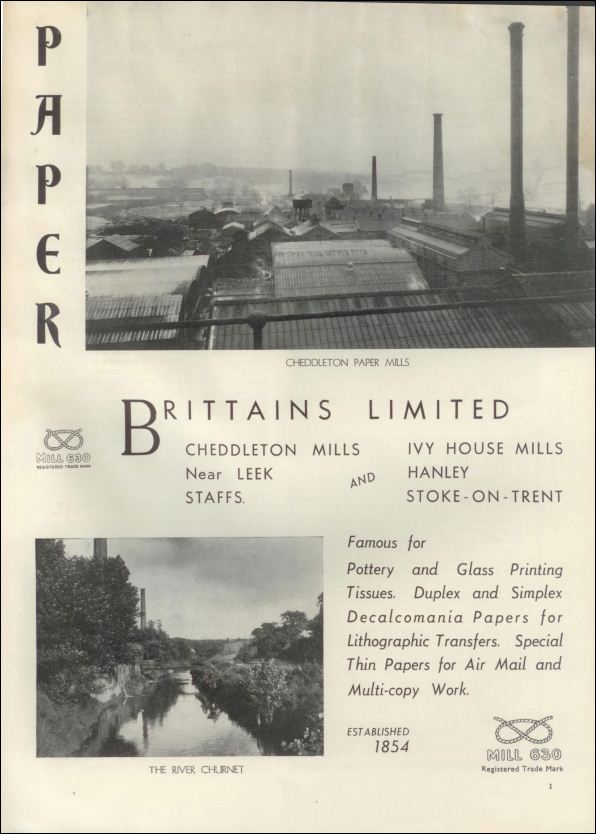
1939 advert
for Brittains Limited
The Pottery Gazette & Glass Trade Review
|

1879
Keates's - Gazetteer & Directory
of the Staffordshire Potteries
Brittains Limited
-
After
the Fourdrinier
brothers were declared bankrut for a final time in 1854 the Ivy
House Mill was taken over by Thomas Brittain in
1855.
-
Brittains
described themselves as ‘successors to the Fourdriniers, the
inventors of the paper machine’.
-
In
1890 his grandson, Thomas Arthur Brittain, and two other members of the family bought a
further paper mill at Cheddleton and incorporated the two businesses as Brittains Ltd.
-
Brittains
specialised in the production of Decalcomania Papers [a
type of transfer paper that allows the transfer a printed image to
another object such as glass or pottery - also called a decal]
for the decoration of pottery and during the 1890's also produced
the first carbonising tissues.
-
Paper-making eventually ceased at the Ivy House Mill which was rebuilt and since 1906 has been devoted to paper coating and finishing.
|

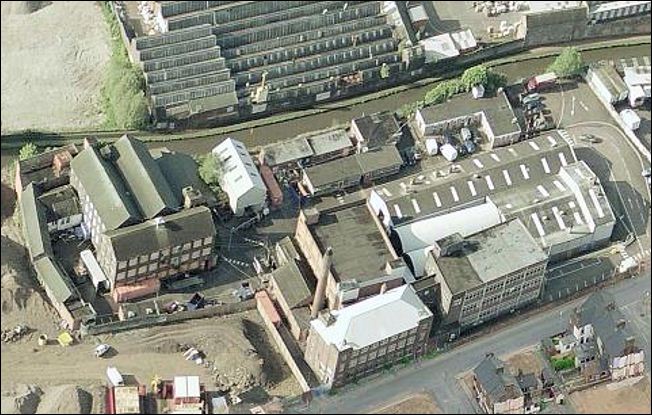
the Brittains Paper Mill site
c.2006
to the rear is the Caldon Canal and to the front is Commercial Road

| The Sort
& Pack Warehouse built in 1924 is three-storey structure with a
frontage to Commercial Road.
The building is
constructed of red brick with concrete detailing - the north façade (on
Commercial Road) is uniformly arranged into seven bays divided by
shallow pilasters. Each bay contains large iron casements to each floor,
under concrete heads with concrete sills. Defining the elevations are
corner turrets containing arched recesses with blue brick detailing.
These rise above the main elevation under low concrete parapets. |
Photo: May 2010
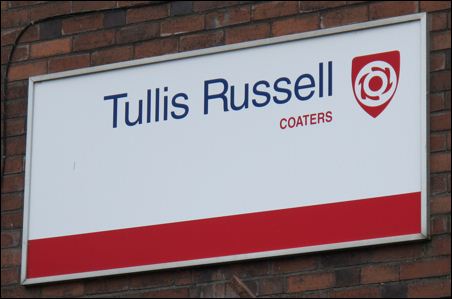
Tullis Russell & Co. took over
the works in the 1970s, and they continued
to produce Decalcomania Papers under the name Tullis Russell Brittains

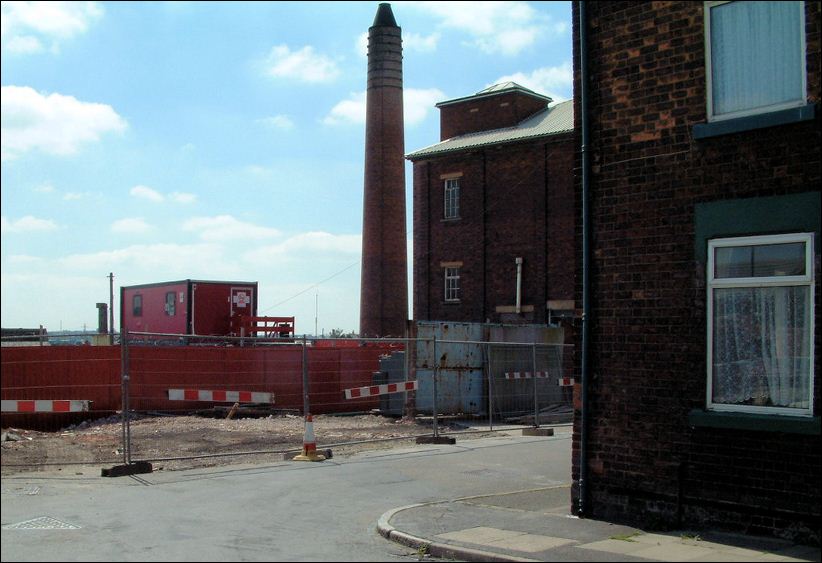
view from Eagle Street - most
of the Ivy House Mill site has been cleared
just the chimney and warehouse remain in this picture
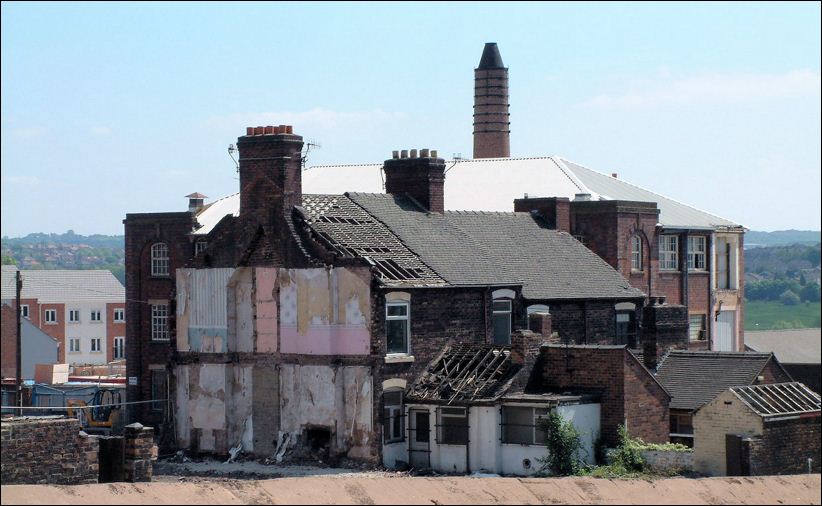
the rear of the last houses to
be demolished in Tintern Street
behind is the last of the buildings of the Ivy House Mill, to the left are
the new Redrow houses on the Waterside development
photos: May 2008

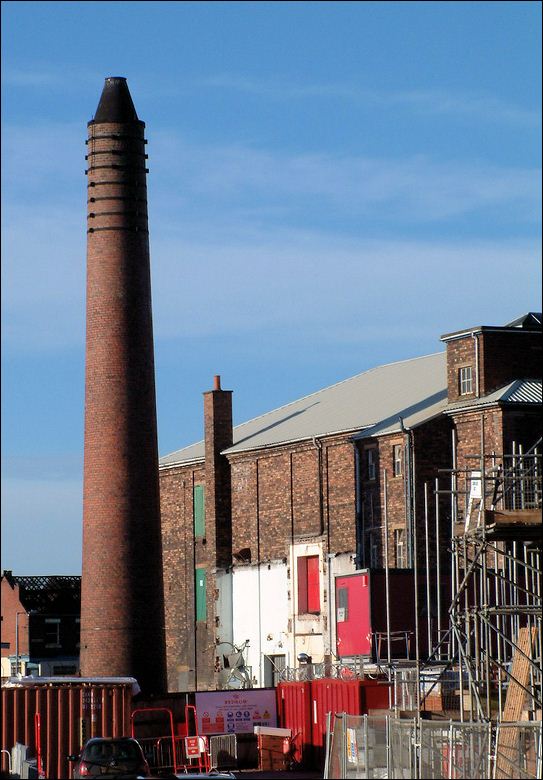
the rear of the warehouse and
the chimney
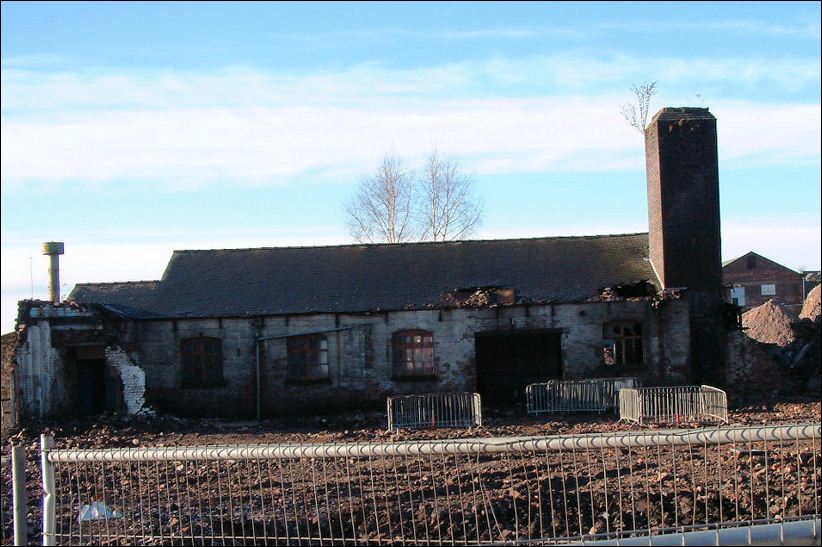
the last remaining building of
the Brittains Paper Mill
- will be demolished in 2013 -
photos: Jan 2008

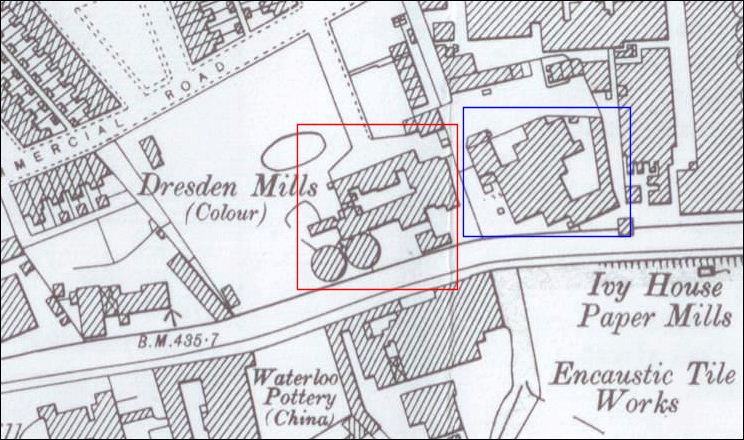
The Ordnance Survey map of 1898
shows the Ivy House Paper Mills (blue square) to the north of the Caldon Canal
Brittains acquired the site of the former Dresden Mills in order
to extend their buildings
|
The
Dresden Colour Mills
(red square) occupied a site to the west of Ivy House Mills.
The
Mill was established by Job Meigh in the early 19th century. In 1834
the trade directories identify Job Meigh as a flint and bone
grinder, by 1840 the mill had passed to Job’s son William who is
listed in the trade directories as ‘Flint and colour grinder
– Dresden Mills’.
The
maps show a range of buildings parallel to the canal enclosing a
central court. Two large circular structures, probably kilns are
shown on the canal edge. |
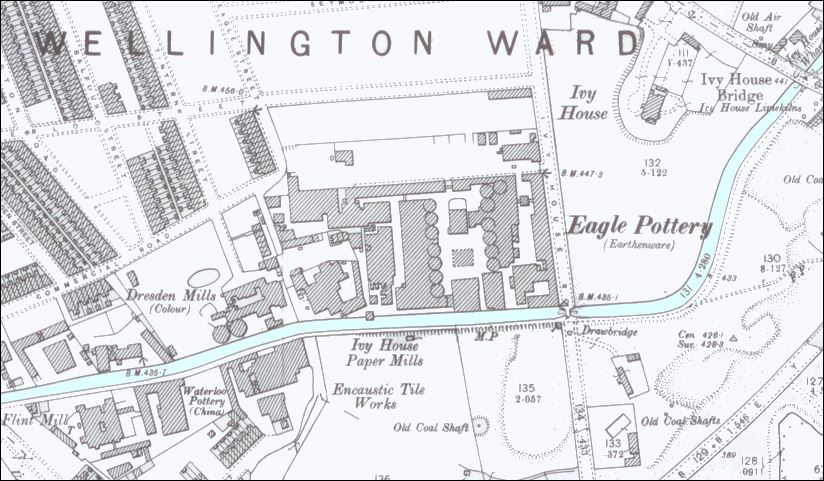
the Ivy House Estate on a 1898
map
the Caldon Canal is shown in blue
The Ivy
House Estate
-
The
Ivy House Paper Mill takes its name from the Ivy House Estate,
located to the northeast of the site.
-
Although
the house itself no longer survives, the name continued to be used
by several industrial premises and roads in the area, including Ivy
House Colliery, Ivy House Foundry, Ivy House Limekilns, Ivy House
Bridge and Ivy House Road.
|

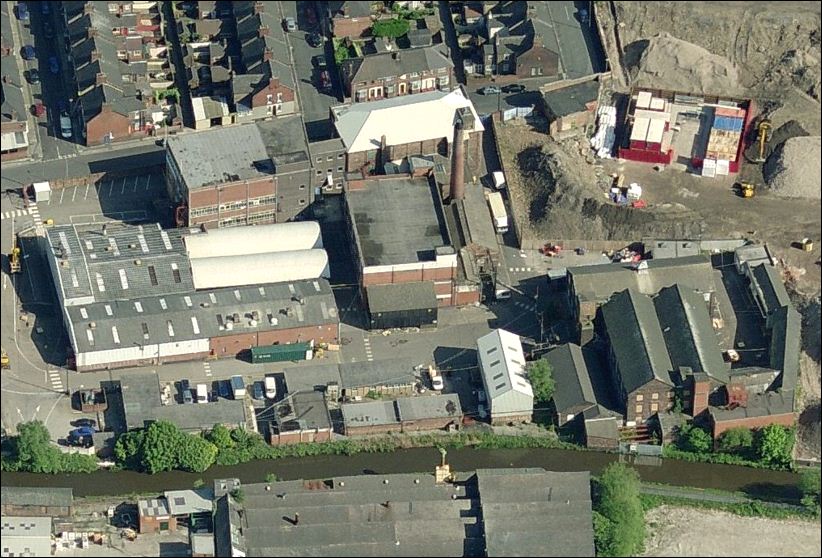
the Brittains Paper Mill site
c.2006
to the rear of the mill is the Caldon Canal and to the front is Commercial
Road (top of the photo)
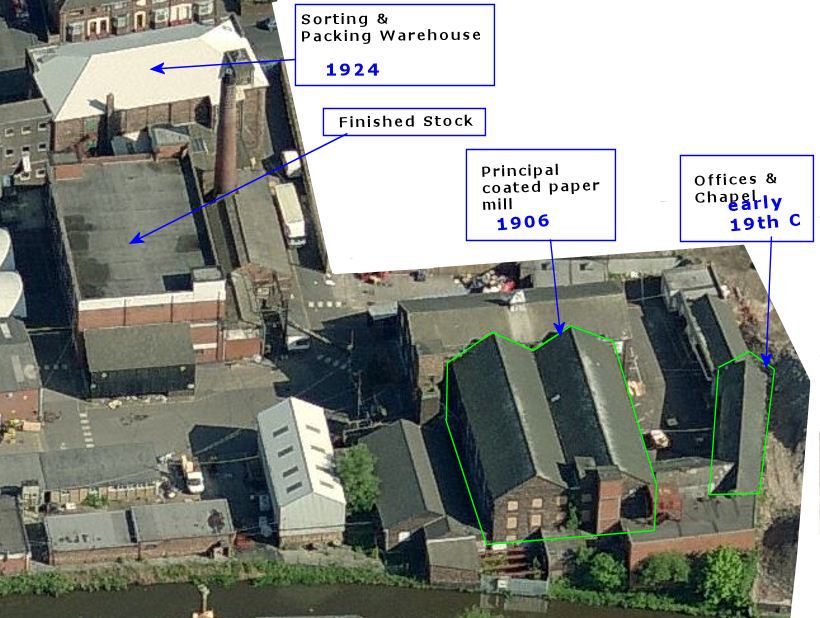
the buildings to the south-west
side of the site were the former Brittains mill and warehouse
-
Brittains
had developed a process for coating paper with gum and starch to
produce duplex paper, a form of paper specifically used for
lithographic machines, in association with this process buildings at
Ivy House Mill were developed in 1906 as a paper coating works and
warehouse.
-
The
rebuilding of Ivy House Mill was undertaken by George Ellis, from
Hanley, to designs by Chapman and Snape of Newcastle.
|




contents: 2013 photos
|
Related
links...
 |
Advert
for Brittains Ltd - from "Prestige and Progress - A
Survey of Industrial North Staffordshire" a 1955 publication
of North Staffordshire Chamber of Commerce |
 |
The
Ivy House and estate lands belonging to it lay to the
south of Bucknall Road - there are still many local references to
its existance. |
|
![]()













